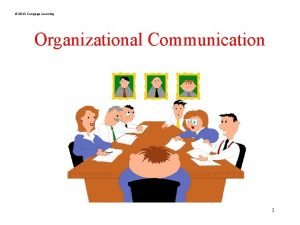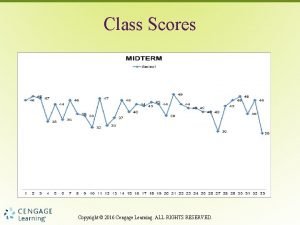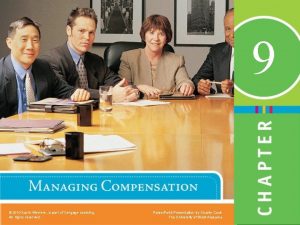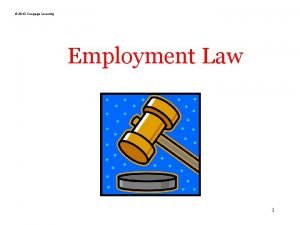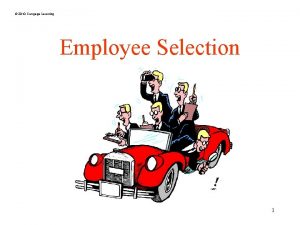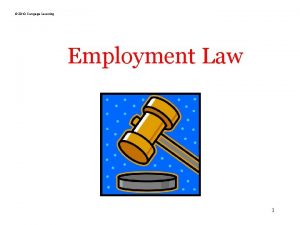8 2010 SouthWestern a part of Cengage Learning


























- Slides: 26

8 © 2010 South-Western, a part of Cengage Learning All rights reserved. Power. Point Presentation by Charlie Cook The University of West Alabama

Performance Appraisal Programs • Performance Appraisal Ø A process, typically performed annually by a supervisor for a subordinate, designed to help employees understand their roles, objectives, expectations, and performance success. • Performance Management Ø The process of creating a work environment in which people can perform to the best of their abilities. © 2010 South-Western, a part of Cengage Learning. All rights reserved. 8– 2

FIGURE 8. 1 Purposes for Performance Appraisal © 2010 South-Western, a part of Cengage Learning. All rights reserved. 8– 3

Developing an Effective Appraisal Program • • What are the performance Standards? Are You Complying with the law? Who should Appraise performance? ( Sources) Putting it all together : 360 – degree Appraisal • Training Appraisers © 2010 South-Western, a part of Cengage Learning. All rights reserved. 8– 4

Developing an Effective Appraisal Program • Performance Standards Ø Must be based on job-related requirements derived from job analysis and reflected in job description and job specifications. Ø Help translate an organization’s goals and objectives into job requirements that define acceptable and unacceptable performance levels. © 2010 South-Western, a part of Cengage Learning. All rights reserved. 8– 5

FIGURE 8. 4 Alternative Sources of Appraisal © 2010 South-Western, a part of Cengage Learning. All rights reserved. 8– 6

Sources of Performance Appraisal • Manager and/or Supervisor Ø Appraisal done by an employee’s manager and reviewed by a manager one level higher. • Self-Appraisal Ø Appraisal done by the employee being evaluated, generally on an appraisal form completed by the employee prior to the performance interview. • Subordinate Appraisal Ø Appraisal of a superior by an employee, which is more appropriate for developmental than for administrative purposes. © 2010 South-Western, a part of Cengage Learning. All rights reserved. 8– 7

Sources of Performance Appraisal • Peer Appraisal Ø Appraisal by fellow employees, compiled into a single profile for use in an interview conducted by the employee’s manager. © 2010 South-Western, a part of Cengage Learning. All rights reserved. 8– 8

Sources of Performance Appraisal • Team Appraisal Ø Based on TQM concepts; recognizes team accomplishment rather than individual performance • Customer Appraisal Ø A performance appraisal that, like team appraisal, is based on TQM concepts and seeks evaluation from both external and internal customers © 2010 South-Western, a part of Cengage Learning. All rights reserved. 8– 9

360 -Degree Performance Appraisal System Integrity Safeguards Jobs are multifacted and different people see different things. As the name implies , 360 degree feedback is intended to provide employees with as accurate a view of their performance as possible by getting input from all angles : supervisors, peers, subordinates , customers and the like. © 2010 South-Western, a part of Cengage Learning. All rights reserved. 8– 10

Training Performance Appraisers Common rater-related errors Error of central tendency Leniency or strictness errors Similar-to-me errors Recency errors Contrast errors © 2010 South-Western, a part of Cengage Learning. All rights reserved. 8– 11

Rater Errors • Error of Central Tendency Ø A rating error in which all employees are rated about average. • Leniency or Strictness Error Ø A rating error in which the appraiser tends to give all employees either unusually high or unusually low ratings. • Recency Error Ø A rating error in which appraisal is based largely on an employee’s most recent behavior rather than on behavior throughout the appraisal period. © 2010 South-Western, a part of Cengage Learning. All rights reserved. 8– 12

Rater Errors • Contrast Error Ø A rating error in which an employee’s evaluation is biased either upward or downward because of comparison with another employee just previously evaluated. • Similar-to-Me Error Ø An error in which an appraiser inflates the evaluation of an employee because of a mutual personal connection. © 2010 South-Western, a part of Cengage Learning. All rights reserved. 8– 13

Performance Appraisal methods • Trait methods • Behavoiural methods • Results methods © 2010 South-Western, a part of Cengage Learning. All rights reserved. 8– 14

Performance Appraisal Methods Graphic Rating Scale Trait Methods Mixed Standard Scale Forced-Choice Essay © 2010 South-Western, a part of Cengage Learning. All rights reserved. 8– 15

Trait Methods • Graphic Rating-Scale Method Ø A trait approach to performance appraisal whereby each employee is rated according to a scale of individual characteristics. • Mixed-Standard Scale Method Ø An approach to performance appraisal similar to other scale methods but based on comparison with (better than, equal to, or worse than) a standard. © 2010 South-Western, a part of Cengage Learning. All rights reserved. 8– 16

2 Graphic Rating Scale with Provision for Comments © 2010 South-Western, a part of Cengage Learning. All rights reserved. 8– 17

3 Example of a Mixed-Standard Scale © 2010 South-Western, a part of Cengage Learning. All rights reserved. 8– 18

Trait Methods • Forced-Choice Method Ø Requires the rater to choose from statements designed to distinguish between successful and unsuccessful performance. Ø 1. ______ a) Works hard Ø 2. ______ a) Shows initiative Ø 3. ______ a) Produces poor quality _____ b) Works quickly _____ b) Is responsive to customers _____ b) Lacks good work habits • Essay Method Ø Requires the rater to compose a statement describing employee behavior. © 2010 South-Western, a part of Cengage Learning. All rights reserved. 8– 19

Behavioral Methods Critical Incident Behavioral Checklist Behavioral Methods Behaviorally Anchored Rating Scale (BARS) Behavior Observation Scale (BOS) © 2010 South-Western, a part of Cengage Learning. All rights reserved. 8– 20

Behavioral Methods • Critical Incident Method Ø Critical incident v An unusual event that denotes superior or inferior employee performance in some part of the job v The manager keeps a log or diary for each employee throughout the appraisal period and notes specific critical incidents related to how well they perform. • Behavioral Checklist Method Ø The rater checks statements on a list that the rater believes are characteristic of the employee’s performance or behavior. © 2010 South-Western, a part of Cengage Learning. All rights reserved. 8– 21

Results Methods • Productivity Measures Ø Appraisals based on quantitative measures (e. g. , sales volume) that directly link what employees accomplish to results beneficial to the organization. • Management by Objectives (MBO) Ø A philosophy of management that rates performance on the basis of employee achievement of goals set by mutual agreement of employee and manager. © 2010 South-Western, a part of Cengage Learning. All rights reserved. 8– 22

FIGURE 8. 6 Performance Appraisal under an MBO Program © 2010 South-Western, a part of Cengage Learning. All rights reserved. 8– 23

The Balanced Scorecard • The appraisal focuses on four related categories Ø Financial, customer, processes, and learning • Ensuring the method’s success: Ø Translate strategy into a scorecard of clear objectives. Ø Attach measures to each objective. Ø Cascade scorecards to the front line. Ø Provide performance feedback based on measures. Ø Empower employees to make performance improvements. Ø Reassess strategy. © 2010 South-Western, a part of Cengage Learning. All rights reserved. 8– 24

FIGURE 8. 7 Summary of Various Appraisal Methods © 2010 South-Western, a part of Cengage Learning. All rights reserved. 8– 25

Appraisal Interviews Types of Appraisal Interviews Tell and Sell - persuasion Tell and Listen - nondirective Problem Solving - focusing the interview on problem resolution and employee development © 2010 South-Western, a part of Cengage Learning. All rights reserved. 8– 26
 2010 cengage learning
2010 cengage learning Delmar cengage learning medical terminology
Delmar cengage learning medical terminology Cengage learning heart diagram
Cengage learning heart diagram Cengage learning heart diagram
Cengage learning heart diagram South-western cengage learning
South-western cengage learning Chapter 13 medical math assignment sheet
Chapter 13 medical math assignment sheet 2009 delmar cengage learning
2009 delmar cengage learning Cengage learning heart diagram
Cengage learning heart diagram Learning exercises chapter 1 medical terminology
Learning exercises chapter 1 medical terminology Cengage learning australia
Cengage learning australia Graphing tpr
Graphing tpr Cengage learning
Cengage learning Cengage learning
Cengage learning Wadsworth cengage learning
Wadsworth cengage learning Cengage learning
Cengage learning Cengage learning plant cell
Cengage learning plant cell Cengage learning
Cengage learning Cengage learning
Cengage learning Brooks cole cengage learning
Brooks cole cengage learning Chapter 7:10 respitory system
Chapter 7:10 respitory system 2014 cengage learning accounting answers
2014 cengage learning accounting answers Cengage chapter 7
Cengage chapter 7 Cengage learning
Cengage learning Cengage learning
Cengage learning Chapter 6 the skeletal system answer key
Chapter 6 the skeletal system answer key Cengage learning
Cengage learning 2009 delmar cengage learning
2009 delmar cengage learning
